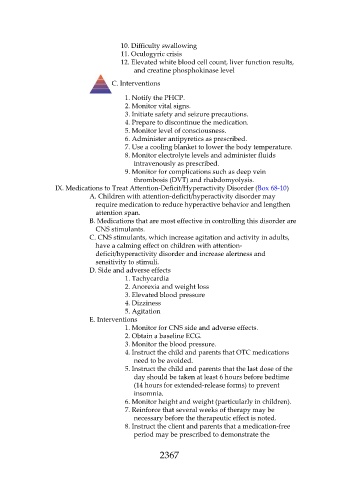Page 2367 - Saunders Comprehensive Review For NCLEX-RN
P. 2367
10. Difficulty swallowing
11. Oculogyric crisis
12. Elevated white blood cell count, liver function results,
and creatine phosphokinase level
C. Interventions
1. Notify the PHCP.
2. Monitor vital signs.
3. Initiate safety and seizure precautions.
4. Prepare to discontinue the medication.
5. Monitor level of consciousness.
6. Administer antipyretics as prescribed.
7. Use a cooling blanket to lower the body temperature.
8. Monitor electrolyte levels and administer fluids
intravenously as prescribed.
9. Monitor for complications such as deep vein
thrombosis (DVT) and rhabdomyolysis.
IX. Medications to Treat Attention-Deficit/Hyperactivity Disorder (Box 68-10)
A. Children with attention-deficit/hyperactivity disorder may
require medication to reduce hyperactive behavior and lengthen
attention span.
B. Medications that are most effective in controlling this disorder are
CNS stimulants.
C. CNS stimulants, which increase agitation and activity in adults,
have a calming effect on children with attention-
deficit/hyperactivity disorder and increase alertness and
sensitivity to stimuli.
D. Side and adverse effects
1. Tachycardia
2. Anorexia and weight loss
3. Elevated blood pressure
4. Dizziness
5. Agitation
E. Interventions
1. Monitor for CNS side and adverse effects.
2. Obtain a baseline ECG.
3. Monitor the blood pressure.
4. Instruct the child and parents that OTC medications
need to be avoided.
5. Instruct the child and parents that the last dose of the
day should be taken at least 6 hours before bedtime
(14 hours for extended-release forms) to prevent
insomnia.
6. Monitor height and weight (particularly in children).
7. Reinforce that several weeks of therapy may be
necessary before the therapeutic effect is noted.
8. Instruct the client and parents that a medication-free
period may be prescribed to demonstrate the
2367

